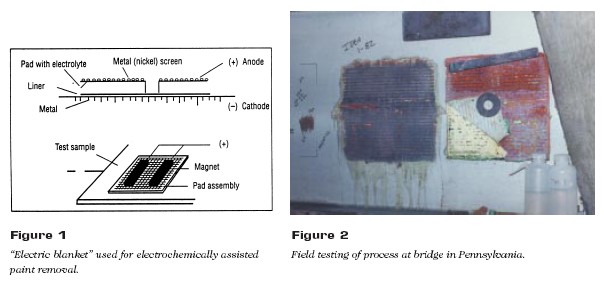This project evaluated an electrochemical cathode debonding process for stripping paint from highway steel structures (Figure 1). The method eliminates airborne paint particles and is a viable alternative to the common abrasive blasting of lead-based paint. In addition, toxic lead components can be collected and recycled. Laboratory tests were carried out to determine concept feasibility and optimize process parameters. The process effectively debonded and removed paint from steel surfaces in 1 to 2 hours using 10-cm x 10-cm electrolytic patches under a constant voltage of 8 to 12 V and a current of 7.5 A or less. A prototype paint removal equipment system was designed for larger-scale testing.
After additional process optimization in the laboratory, small-scale field tests on highway bridges and steel structures were performed to establish the application’s feasibility in actual highway structures (Figure 2). The field work shows promising results. Some initial surface preparation may be necessary to initiate the process. A supplemental IDEA award was approved for full-scale field demonstration of the technology on highway bridges in collaboration with the Virginia Department of Transportation (NCHRP-IDEA #38). The final report is available from the National Technical Information Service (NTIS # PB97-141980).

The final report for this IDEA project can be found at:
https://onlinepubs.trb.org/onlinepubs/archive/studies/idea/finalreports/highway/NCHRP023_Final_Report.pdf